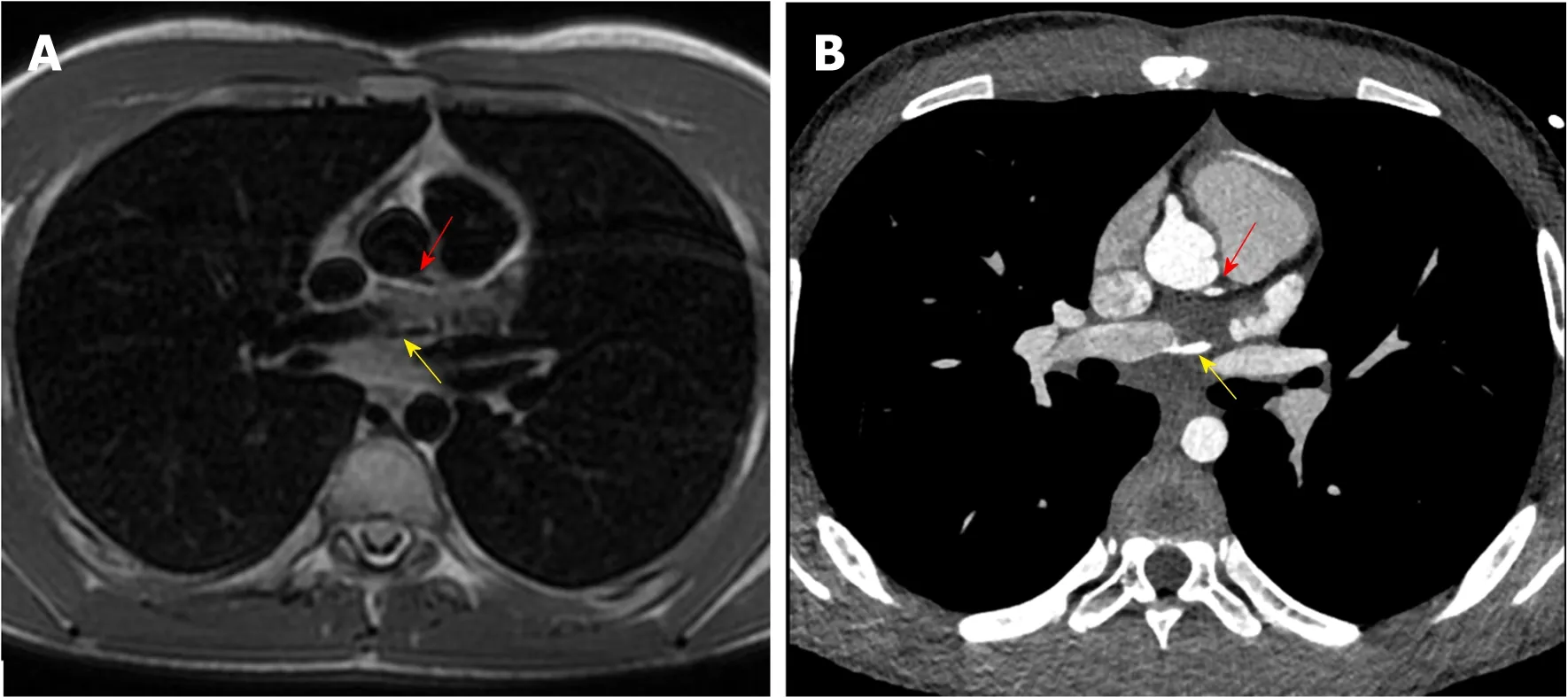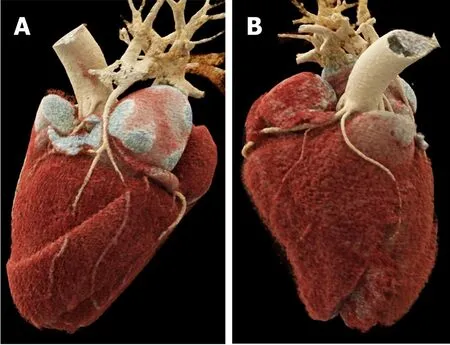Diagnostic detection with cardiac tomography and resonance of extremely rare coronary anomaly:A case report and review of literature
2019-04-20NicolSchicchiMarcoFoganteGianMarcoGiuseppettiAndreaGiovagnoni
Nicolò Schicchi,Marco Fogante,Gian Marco Giuseppetti,Andrea Giovagnoni
Abstract
Key words: Coronary anomalies; Cardiac computed tomography; Cardiac magnetic resonance; Case report; Coronary artery anomalies
INTRODUCTION
Congenital coronary artery anomalies (CAAs) are uncommon and frequently associated with other cardiac malformations.Extremely rare is the contemporary association of two CAAs[1,2].With adequate coronary collateralisation,the clinical course may be silent but,sometimes,patients may had severe clinical outcomes,including sudden cardiac death (SDC),and need surgical treatment in infancy.For these reasons,early detection and exact delineation of coronary origin and course are essential[3,4].Most of CAAs are diagnosed by invasive procedure,like coronary angiography (CX-A),or during surgical treatment.
Here we describe the first case of a pediatric male patient with origin of left circumflex (LCx) artery from right pulmonary artery (RPA) associated with origin of left anterior descending (LAD) artery from right coronary artery (RCA).These anomalies were suspected with cardiac magnetic resonance (C-MRI) and confirmed with cardiac computed tomography (C-CT) with very low radiation dose and without the risks related to invasive procedure,like CX-A.
CASE PRESENTATION
Chief complaints
A healthy 10-year-old male patient (weight 53.3 kg and height 158.4 cm) was referred to the Radiological Department of our Institution.
History of present illness
He had not familiarity and risk factors for cardio-vascular diseases,congenital heart disease,arrhythmias and SCD.Karate practitioner (3 times/wk) without problems.Asymptomatic for chest pain,dyspnea,palpitation and syncope episodes.
History of past illness
The patient had a free previous medical history.In particular,born at term (38 wk),childbirth without any complications and birth weight was 2.4 kg.Regular growth.
Physical examination
Physical examination revealed no sign of cardiopathy and without any cardiac added noises at chest auscultation.The patient’s temperature was 36 °C,heart rate was 72 bpm,respiratory rate was 13 breaths per minute,blood pressure was 110/70 mmHg and oxygen saturation in room air was 98%.
Laboratory examinations
Blood analysis revealed normal haematocrit and platelet count.The blood biochemistries,as well as urine analysis were normal.Creatinine value was 0.9 mg/dL and creatinine clearance was 106 mL/min (estimated with Cockcroft-Gault formula).
Imaging examinations
Electrocardiography showed sinus rhythm,correct atrial-ventricular conduction (QRS 0.09 ms) and non-specific alterations of ventricular recovery (QTc 0.39 ms).Echocardiographic findings included normal volumes of left ventricle and atrium.Normal function of atrioventricular,aortic e pulmonary valves.No septal defects.Normal diameter of ascending aorta.No pericardial effusion.RCA origin high and ectatic.Left coronary artery origin and course not detect.For these reasons,patient was undergoing to C-MRI.
Further diagnostic work-up
C-MRI (Achieva,Philips Medical Systems,The Netherlands) using a 1.5-T scanner was performed.Was used a 32-channel MR cardiac array coil with patient in prone position.C-MRI protocol consisted of balanced steady-state free precession (BSSFP)cine-imaging,T2-weighted and T1-weighted inversion recovery images,and sequences for late enhancement evaluation.Contrast agent dose was 0.2 mL/kg(gadobutrol,1.0 mmol/mL) with flow injection rate of 2.0 mL/s.BSSFP sequences were acquired in the three cardiac axis,T2-weighted and T1-weighted in transversal cardiac axis,and sequences after contrast agent in short cardiac axis covering the entire left ventricle.The exam showed concordance in atrial-ventricular and ventricular-artery communication,regular return of superior vena cava and pulmonary veins.Left ventricle normal for volume,thickening of posterior wall with multiple mitral accessory ropes.Regular contractile functionality (ejection fraction of 71%).Accentuated endocardial trabeculation.Regular volume of left atrium.Regular right cardiac sections.Probable anomalies of origin and course of LCx and LAD arteries.For this reason,the patient was scanned with third generation Dual Source CCT 192 × 2-sections (SOMATOM Force,Siemens,Germany).Patient remained in sinus rhythm before examination without receiving βblocker.Patient received a non-ionic low-osmolality contrast agent Visipaque 320 mgI/mL (iodixanol; GE Healthcare Life Sciences,Chalfont,United Kingdom),with a volume of 30 mL and flow injection rate of 5 mL/sec followed by saline injection at same volume and velocity.The scanning area began from the upper limit of the sternum to 1 cm below the diaphragm with superior to inferior direction.The parameters used for the exam were:70 kV of tube voltage; automatic tube current modulation technique (CAREdose); rotation time,0.28 sec; detector array,192 × 0.6 mm; slice thickness,0.75 mm and convolution kernel of B26.Was applied prospective ECG-triggered axial coronary protocol in a step-andshoot scan mode and the exposure time was adjusted between 40%-70% of the cardiac cycle.After the examination,radiation CT dose index,dose length product and effective dose were recorded.Then the raw data was post-processed and was included the capture of the optimal images,multi-plane and maximum intensity projection reconstructions and volume rendering representations.C-CT confirmed anomalous origin of LCx artery from RPA associated with anomalous origin of LAD artery from RCA with proximal-medium course in front of RVOT and presences of coronary interconnections.Moreover,the examination showed the origin of a small diagonal branch from the left coronary sinus for the vascularization of the left ventricle wall (Figures 1-5).
FINAL DIAGNOSIS
The final diagnosis of the presented case is anomalous origin of LCx artery from RPA associated with anomalous origin of LAD artery from RCA with proximal-medium course in front of RVOT and presences of coronary interconnections.
TREATMENT
The young patient underwent surgical treatment.The procedure began with standard median sternotomy,chest opening,thymus removal and pericardium opening.Then were cannulated the innominate artery and right atrium for cardiopulmonary bypass.After pulmonary arteries were clamped,the child was cooled down to 16 °C core temperature and circulatory arrest was commenced.Primarily,LCX was dissected from the RPA with a generous cuff,and was re-implanted into the wall of the aorta.Secondly,LAD was dissected from RCA and re-implated into the wall of aorta.Finally,after full rewarming,the operation was concluded and the sternum was closed.

Figure 1 Origin of left circumflex artery and small diagonal branch.
OUTCOME AND FOLLOW-UP
The patient had an uneventful postoperative clinical course.At follow-up visit,two months after surgical treatment (one month after hospital discharge),the patient was asymptomatic.Follow-up C-MRI,four months after operation,showed complete success of surgery treatment.
DISCUSSION
Based on scientific works present in literature,the prevalence of CAAs in general population is around 1%; with a range from 0.3% to 5.6% in studies on patients undergoing CX-A,and in approximately 1% of routine autopsy.About 26% of CAAs are associated with other congenital cardiac malformations[5-7].Separate origin of the LAD and LCX represents the commonest CAA with an incidence of 0.41%,followed by LCX arising from the RCA,with an incidence of 0.37%[8-10].These anomalies,could be asymptomatic,but in some cases may lead to myocardial infarction,arrhythmia,ventricular aneurysm,mitral regurgitation,cardiomyopathy and SCD and they represent the second most common cause of SDC in young athletes.Therefore,the symptoms depend to the expansion of collateral vessels from coronary arteries.For this reason,patients need surgical treatment in early infancy[3,4].Some potential pathogenetic mechanisms have been proposed to explain ischaemia and SCD,such as endothelial injury of the anomalous coronary artery with consequent sudden coronary spasm or modification of physiologic blood circulation.Another possible cause of ischemia is the acute angle of take-off of the anomalous vessel and the related slit-like orifice,which may become kinked and occluded during exercise[11-14].Otherwise,it is interesting to note that in nearly 15% of patients with CAAs,myocardial ischemia can develop in the absence of atherosclerosis.For this reasons,early detection of CAAs and concomitant congenital cardiac malformations are crucial[15-17].
Although CX-A is still widely used in childhood,C-MRI and C-CT have recently taken on an increasing role in the diagnosis of CAAs.Indeed the association,of these two non- invasive examinations,allows the evaluation of cardiac morphology and functionality,with high spatial and temporal resolution,and permits to assess,exactly,coronary anatomy,without the risks related to invasive procedure and patient sedation and with a very low radiation dose[18-25].
Here we reported the case of a 10-year-old male patient with anomalous origin of LCx artery from RPA associated with anomalous origin and course of LAD artery from RCA in front of RVOT.This association was suspected with C-MRI and confirmed with C-CT without the necessity of CX-A,or other invasive procedures.To the best of our knowledge,the presented case is the first one in scientific literature that describes this anomaly association.Moreover,of 12 similar cases of CAAs reported in literature,only 2 were detected and confirmed with C-MRI or C-CT,the others were diagnosed with CX-A or during surgical treatment[26-37].Our patient was a healthy child with no previous serious or recurrent or unusual cardiac symptoms.Electrocardiography examination was regular but with echocardiography,left coronary artery origin and course was not detect.For these reasons patient was undergoing to C-MRI.This exam provided informations on cardiac morphology and functionality and allowed to suspect anomalous origin and course of coronary arteries.Subsequently,third generation dual source C-CT electrocardiogram-gated,with high spatial resolution,guaranteed the detection of exact origin and course of coronary arteries,estimation of their diameter,and visualization of collateral vessels from coronary arteries.The radiation dose was very low,as summarized in Table 1,with effective dose of 3.87 mSv and without risks related to an invasive procedure and patient sedation.The patient had an uneventful postoperative clinical course and follow-up C-MRI showed complete success of surgery treatment.

Figure 2 Course of circumflex artery.
CONCLUSION
Although CX-A is still widely used in childhood for the diagnosis of CAAs,C-MRI allows the evaluation of cardiac morphology and functionality and C-CT,with high spatial resolution,allows to evaluate,with high diagnostic accuracy,CAAs in children,without the risks related to invasive procedure and patient sedation and with a very low radiation dose.

Table 1 Dose report

Figure 3 Origin of left anterior descending artery.

Figure 4 Course of left anterior descending artery.

Figure 5 Coronary artery anomalies in volume rendering reconstruction.
杂志排行
World Journal of Clinical Cases的其它文章
- Clinical presentation and early predictors for poor outcomes in pediatric myocarditis:A retrospective study
- Safety of an improved patent ductus arteriosus occluder for transcatheter closure of perimembranous ventricular septal defects with abnormally attached tricuspid chordae tendineae
- Adiponectin gene polymorphisms and risk of gestational diabetes mellitus:A meta-analysis
- Maternal serum level of resistin is associated with risk for gestational diabetes mellitus:A meta-analysis
- Docetaxel,cisplatin,and 5-fluorouracil compared with epirubicin,cisplatin,and 5-fluorouracil regimen for advanced gastric cancer:A systematic review and meta-analysis
- Sustained complete response to erlotinib in squamous cell carcinoma of the head and neck:A case report
